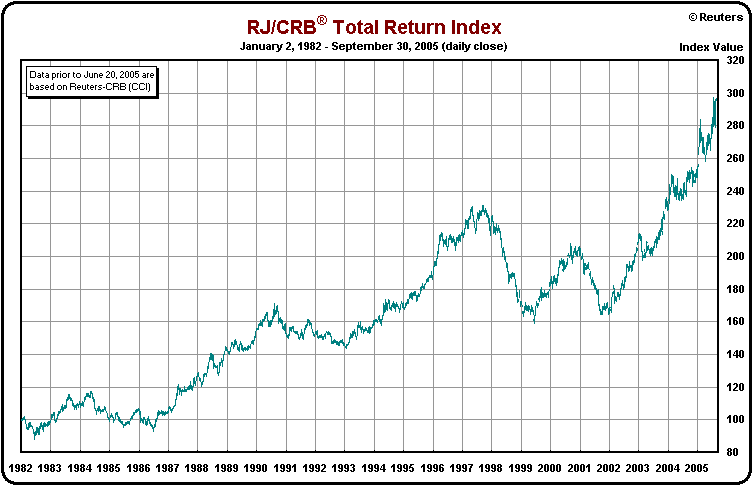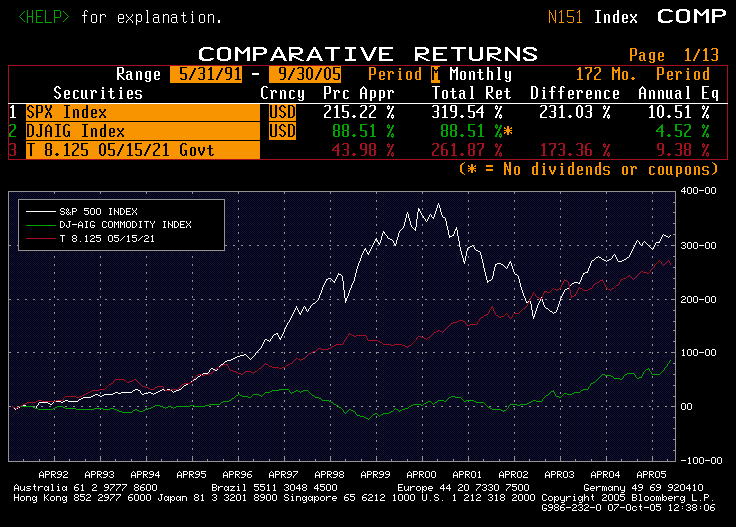Gone4Good
Give me a museum and I'll fill it. (Picasso) Give me a forum ...
- Joined
- Sep 9, 2005
- Messages
- 5,381
Hi all,
Over the past several days (weeks?) I've been in numerous discussions about the merits of diversifying ones portfolio with some commodity exposure. If you're all getting tired of it, fear not, so am I. Not withstanding my fatigue, I spent some time doing some scenario analysis using the portfolio tools at the following site:
www.riskgrades.com
If you haven't been to RiskGrades before, its worth a gander. The free site allows you to test the diversification benefits of a portfolio and run some scenario analysis to see how changes in the portfolio affect its overall risk.
Considering how new the PCRDX fund is, I'm not sure how valid the results are. But here is what I found when adding about 10% PCRDX exposure to my existing portfolio:
1) PCRDX alone carries a "risk grade" of 111 which means that only "1% of 'US Funds' are riskier than PCRDX" (please see the site for definitions). The Vanguard S&P 500 Index fund carries a "risk grade" of 41, which means that "46% of 'US Funds' are riskier than VFIAX"
2) When adding PCRDX by selling equity funds, my portfolio risk grade went down (meaning the portfolio is LESS risky).
3) When adding PCRDX by selling bonds, my portfolio risk grade went UP (meaning the portfolio is MORE risky).
4) When adding PCRDX by selling money market funds, my portfolio risk grade went UP.
The conclusion, at least according to RiskGrades, is that PCRDX can reduce the risk of a portfolio if it replaces equity exposure but will increase the risk profile of the portfolio if it replaces fixed income investments.
Cheers.
Over the past several days (weeks?) I've been in numerous discussions about the merits of diversifying ones portfolio with some commodity exposure. If you're all getting tired of it, fear not, so am I. Not withstanding my fatigue, I spent some time doing some scenario analysis using the portfolio tools at the following site:
www.riskgrades.com
If you haven't been to RiskGrades before, its worth a gander. The free site allows you to test the diversification benefits of a portfolio and run some scenario analysis to see how changes in the portfolio affect its overall risk.
Considering how new the PCRDX fund is, I'm not sure how valid the results are. But here is what I found when adding about 10% PCRDX exposure to my existing portfolio:
1) PCRDX alone carries a "risk grade" of 111 which means that only "1% of 'US Funds' are riskier than PCRDX" (please see the site for definitions). The Vanguard S&P 500 Index fund carries a "risk grade" of 41, which means that "46% of 'US Funds' are riskier than VFIAX"
2) When adding PCRDX by selling equity funds, my portfolio risk grade went down (meaning the portfolio is LESS risky).
3) When adding PCRDX by selling bonds, my portfolio risk grade went UP (meaning the portfolio is MORE risky).
4) When adding PCRDX by selling money market funds, my portfolio risk grade went UP.
The conclusion, at least according to RiskGrades, is that PCRDX can reduce the risk of a portfolio if it replaces equity exposure but will increase the risk profile of the portfolio if it replaces fixed income investments.
Cheers.


